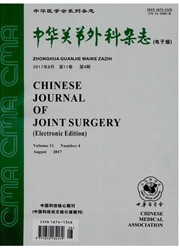

 中文摘要:
中文摘要:
目的探讨人工膝关节置换术(TKA)后应用局部超声药物透入利多卡因辅助镇痛的效果分析。方法2013年1月至2013年9月共100例单侧人工TKA患者随机分为研究组和对照组各50例。两组患者分别给予相同基础镇痛方案,从术后24h起研究组患者辅助局部超声透入利多卡因治疗至术后7d,2次/d,随访两组患者至术后3个月,分别录记术前、术后24h、48h、72h、96h、7d的静止和运动VAS评分,记录记术前、术后48h、72h、96h、7d、术后6周及术后3个月的膝关节活动度,记录术前及术后3个月末次随访的KSS膝关节功能评分,记录患者住院期间接受盐酸哌替啶肌注次数。应用SPSS17.0进行数据分析。结果95例(研究组48例,对照组47例)患者最后完成随访进入统计学分析:(1)两组手术前及术后24h的静止、运动VAS结果比较无统计学差异(P〉0.05);术后48、72、96h、7d静止、运动VAS结果比较研究组优于对照组(P〈0.05);(2)术前及术后6周、术后3个月膝关节活动度两组无统计学差异,术后48h、72h、96h、7d膝关节活动度研究组优于对照组,结果有统计学差异;(3)HSS膝关节评分术前研究组、对照组(37±7)分、(36±6)分,无统计学差异(P〉0.05),术后3个月分别增加至(87±11)、(81±10)分,研究组优于对照组,差别有统计学差异(P〈0.05);(4)两组患者接受盐酸哌替啶肌注次数研究组少于对照组,差别有统计学意义(χ2=10.46,P〈0.05)。结论超声药物透入利多卡因能够有效缓解TKA术后疼痛,减少盐酸哌替啶用量,有助于膝关节术后早期功能康复,是TKA术后镇痛的有益辅助。
 英文摘要:
英文摘要:
Objective To evaluate the effects of the local lidocaine drug phonoporesis for analgesia after the total knee arthroplasty (TKA).Methods From January 2013 to September 2013, 100 patients undergoing TKA in our department were randomly divided into the study group and the control group, each of which involving 50 patients.The same basic peri-operative analgesia protocol was given to each group , while the local lidocaine drug phonoporesis was given to the study group only , twice per day , from 24 h to the 7th day postoperatively .The data were recorded during a three-month follow-up, including:the visual analogue scale ( VAS) at rest and during activity pre-operatively and in 24 h, 48 h, 72 h, 96 h, and 7th day postoperatively;the range of motion of the knee pre-operatively and at 48 h, 72 h, 96 h, 7th day, six weeks, and three months post-operatively;HSS scores pre-operatively and three months after the operation; as well as the frequency that the patients received pethidine hydrochloride intramscular injection.SPSS 17.0 was used for data analysis .Results A total of 95 patients, 48 in the study group and 47 in the control group, completed the final follow-up and were included in the results analysis .(1) VAS scores:Between the two groups , there was no significant difference in the VAS scores at rest and during activity preoperatively and 24 h post-operatively ( P〉0.05 ) .The patients of the study group had obviously lower VAS scores in 48 h, 72 h, 96 h, and seven days post-operatively (P〈0.05).(2) Range of motion ( ROM):There was no significant difference in the ROM between the two groups pre-operatively , as well as in six weeks and three months post-operatively ( P〉0.05 ) .The ROM of the study group was better than that of the control group at 48 h,72 h, 96 h, and 7th day post-operatively.(P〈0.05) (3) The average HSS scores of the study group and the control group were ( 36 ±6 ) and ( 34 ±6 ) points pre-operatively .There was no significant diffe
 同期刊论文项目
同期刊论文项目
 同项目期刊论文
同项目期刊论文
 期刊信息
期刊信息
